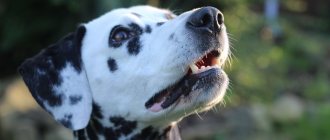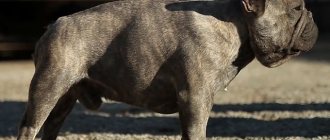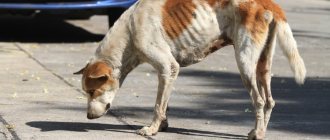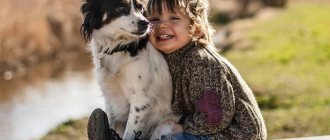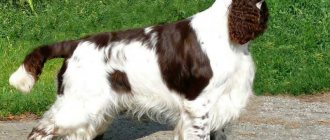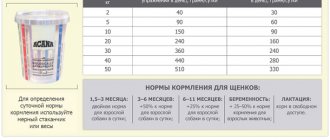The Dalmatian is one of the most charming and peaceful breeds. They stand out on city streets due to their unusual color with black spots. This is a good-natured dog that infects the people around him with positivity and optimism. He is loved for his lack of aggression, high intelligence and devotion to people. It is not recommended to have such a dog as a fashion accessory. For a pet to become a true friend and companion, it must be raised correctly.
Characteristics and description of the breed
This is an energetic, beautiful breed that has gained immense popularity thanks to the famous cartoon. Despite its aristocratic appearance, the large dog was previously used for hunting. Now he is used as a companion dog. Thanks to its good disposition and restraint, the animal gets along well with children.
Aggressiveness
Dalmatians are distinguished by their kindness and devotion. They are loyal friends and enjoy playing with children and other pets. They are not aggressive, but in case of danger they are able to protect a person. The dog will not fawn over a stranger, but will not rush at strangers either. The attitude towards “strangers” is wary and non-aggressive.
Activity
The dog is quite active and requires long walks. It is recommended to keep her in a private home with the possibility of free walking. If the dog does not walk much, he becomes uncontrollable and can cause mayhem in the house.
Training
The dog learns quickly even with an owner who has never trained before. She trusts her owner and enjoys learning new things. The dog remembers learned commands for the rest of his life.
Shedding
Dalmatians shed all year round. The intensity increases in spring and autumn. Breeders consider this one of the disadvantages of the breed.
Need for care
These dogs have almost no smell. Washing is often replaced by wiping with a damp towel so as not to dry out the skin. They also trim nails, comb, and clean eyes and ears.
Friendliness and attitude towards children
The dog gets along well with children and animals in the house. You can safely leave the animal in the same room with a 5-6 year old preschooler. It is better if the puppy and child grow up together.
Health
If properly maintained, the dog rarely gets sick and can live from 10 to 13 years. Diseases of the breed: urolithiasis, dermatitis, allergies.
Attitude towards loneliness
This breed is very attached to people. The long absence of owners leads to melancholy. When a person is constantly busy and cannot give the necessary attention to a pet, the dog “winds up” himself that he is no longer loved.
Maintenance cost
The cost of maintenance varies from 5 to 15 thousand rubles. It depends on the purpose of the purchase (companion dog for home, exhibition, breeding), the animal’s diet (natural dog, food) and other nuances.
Intelligence
The breed is distinguished by high mental abilities. The dog quickly remembers what is happening around him and is trained. He is able to adapt to the mood of the owner and his family members.
Noise
The dog is quite emotional and noisy. She is prone to an active lifestyle. When expressing feelings, he barks a lot and “talks” to people. In the absence of a person, it can howl.
Security qualities
Despite its harmless appearance, this is a dog with a developed guard instinct. In case of danger, it will protect property and people. The dog rarely bites; he scares the uninvited guest more.
Lifespan
A dog can live from 11 to 13 years. The maximum life expectancy reaches 17 years.
The purpose and character of the Dalmatian
Dalmatians have a very multifaceted character.
They tend to be dominant, so from puppyhood it is very important to train the dog and show who is boss. You should not indulge in even cute-looking pranks, otherwise in the future the Dalmatian will simply sit on your neck. They are very family dogs, social and curious. They don’t lie quietly on the rug, but poke their noses everywhere. If you drive them away without paying due attention, they begin to behave badly - they chew furniture, shoes, and throw things around. In a word, Dalmatians should always be with you and at work, that’s why they are companions. These dogs have a lot of natural strength and power. They are simply tireless revelers and require prolonged daily exercise. They will be happy to play, run next to the owner's bicycle, and go to the mountains. Lack of physical activity affects behavior and then health. Keeping it in an enclosure or in an apartment without frequent long walks is absolutely not suitable.
They also have such a negative character trait as vindictiveness. Try to be fair with your pet, do not offend him, be sensitive to his needs. The Dalmatian is a proud dog, it does not tolerate familiarity and, on occasion, can take revenge for disrespect.
Despite their hot temperament, Dalmatians are quite silent; they bark only when necessary. They behave with restraint with strangers and do not show aggression. They are considered good nannies and companions for children. There are many cases where Dalmatians protected and protected their little charges - in this case, the dog considers itself to be in charge and is responsible for the value entrusted to it.
The Dalmatian is considered one of the most charming and exotic dog breeds. It attracts attention not only with its unusual spotted colors. He is loved for his reserved disposition, for his sociability and good nature, for his loyalty and reliability. This is an intelligent and sensitive animal and should not be kept as a fashion accessory. With proper upbringing and careful care, the dog will become a loyal friend to its owner.
Story
The first mention of this breed is found in ancient Egyptian scrolls. These descriptions are so scarce that it is impossible to understand who the ancestors of exotic dogs were. The most informative and reliable evidence is considered to be the description of Dalmatians in the 15th-16th centuries. These dogs are present in portraits of Venetian artists and frescoes of monasteries.
It is believed that the breed originated from Croatia, and when breeding the breed, black pointers and white English terriers were used. Dalmatians continued to be improved by British breeders and at the end of the 17th century the appearance of modern Dalmatians became recognizable.
It was discovered that the dog does not get tired for a long time and runs, keeping up with horse-drawn carriages. For this reason, Dalmatians were bred to guard property and people during long journeys and journeys. These animals also urged tired or unruly horses.
In England they were called carriage dogs. They were also used as game hunters and to protect society ladies. Dalmatians were considered a sign of the high status of the owner.
In America, Dalmatians have evolved from hunting dogs into alert dogs for firefighters. They signaled that a carriage was moving to extinguish the flames. These dogs are considered the mascot of firefighters in America.
The official breed standard and the first breeders' club were formed in 1890. This breed appeared in Russia in the 80s of the last century. But she still remained rare, the demand for puppies was not so great. The greatest spread of the breed in our country began in the nineties of the 20th century.
History of the breed
The history of this breed is unlikely to surprise you; there is very little accurate data and a lot of blank spots. It is impossible to say for certain when, how and where Dalmatians appeared. 20 years ago, the official version was taken to be the European origin of Dalmatians. On the Balkan Peninsula there was the province of Dalmatia, and supposedly these dogs appeared there, bred by crossing Great Danes, Istrian Pointers and other breeds.
There are versions that Dalmatians could have lived in Ancient Egypt; drawings that strongly resembled these dogs were discovered on the walls of the pyramids. There was also an assumption that Dalmatians came to Europe from India. The only thing we can say for sure is that this breed is very ancient and appeared before our era.
In the modern development of the breed, everything is more or less clear. From the mainland, Dalmatians came to England, where noble families loved them for their appearance, strength and tough disposition. Dalmatians began to be bred and raised as carriage dogs. Their duties were to run in front of the master's carriage and disperse people. At first glance, the Dalmatian may seem sweet, but in fact, in the past they were quite aggressive and cruel dogs. Modern animals also have these notes of temperament
Appearance (breed standards)
The Dalmatian Dog is a large dog with a developed, athletic body and strong limbs. The height at the withers varies from 54 to 62 centimeters, depending on gender. This breed is considered medium in size among other dogs. Representatives of this breed are distinguished by their endurance when running. Their long legs have soft pads that give them good traction on the surface.
- A male Dalmatian weighs from 27 to 32 kg.
- Bitches are slightly smaller, their weight reaches 24-29 kg.
Head
Dalmatians have a proportional head. It is slightly elongated. There are no skin folds on it. The skull is flat, wide between the ears. The transition from forehead to nose is moderate.
Eyes
These dogs have medium-sized eyes, the color of which depends on the color. Individuals with black spots have dark brown eyes. Those with amber spots have lighter eyes.
Ears
The Dalmatian's ears are large and widely spaced. They are triangular in shape and slightly rounded at the ends. The ears are covered with spots in the color of the main color.
Jaws
The jaws are strong and have a scissor bite. The upper row of teeth completely hides the lower one.
Torso
The animal's loin and croup have a slight slope. The dog's body is muscular and well built, the stomach is retracted. The chest is voluminous with long ribs.
Neck
This breed of dog has a long neck with a slight bend. It tapers towards the head.
Tail
The tail has a medium height set. It reaches the hock joint. The tail has a wide base and tapers towards the tip. If the dog is calm, the tail hangs. When the Dalmatian is excited, it rises parallel to the floor (ground).
Paws
The front legs are straight with the elbows pressed to the body. The hind legs are more muscular, with strong knees. The toes are well formed and look like cat paws. The pigment of the claws depends on the color of the animal.
Wool
The animal has shiny, smooth, hard fur. The hair is practically odorless and thick. The dog sheds all year round.
Color
Dalmatians are white with black or brown spots scattered over the body. If the spots have a gray, lemon or other tint, then these dogs are not recommended for exhibitions.
The ideal spot size is up to 3 centimeters. Markings on the body, head and limbs should not merge.
If the dog is tri-colored, it is considered a violation of the breed standard. Such Dalmatians are not allowed to show.
Character of the breed and behavioral characteristics
The Dalmatian is a cheerful and mischievous dog who loves to play with both his brothers and children or adults. This dog wants to be the center of attention. The Dalmatian very often begins to claim the role of the main child. If he is not allowed to do this, then he is ready to take another place, the one indicated by the owner.
When such a dog does not lead an active life, he is sad, offended by everyone, like a child who lacks attention and care from his peers. His beautiful, naturally gentle character turns into harmful and rebellious.
The Dalmatian dog breed has a calm disposition. Its representatives are reserved towards unfamiliar citizens. These dogs do not come into contact with everyone they meet. They are very attached to the owner and family. For children, such a dog will become a real nanny. He will protect the kids from strangers.
For centuries, the Dalmatian dog breed has been bred for hunting; in addition, it has clearly expressed innate watchdog qualities. Dalmatians do not bark very often, but if something suspicious appears on the horizon, they will let you know.
Usually in an apartment such a dog feels like the master, and sometimes does not tolerate the presence of other dogs. On walks, the breed is very calm and friendly. Does not tolerate aggressive and barking dogs.
The Dalmatian, of course, has a very kind disposition, but if the owner is in danger, the dog becomes fearless and brave. He will undoubtedly engage in battle with the enemy, and it does not matter whether it is a person or an animal. Size doesn’t matter either; the dog will still protect the owner with all his might. The Dalmatian makes a great friend who, if necessary, can stand up for the owner. This dog loves long walks, loves to run, and also searches the territory.
Needs constant communication with people, especially the owner and family members. When a Dalmatian is left alone, he becomes very bored, perhaps even nervous.
If such a dog is poorly trained, for example, punished or rewarded for the same action, then it will develop aggression. The dog may even become nervous and dangerous. Constant punishment without reason should also not be present, otherwise his character will break and he will become unsuitable for service as a watchman, since he will not react in any way to strangers.
Character
The dog is active and friendly. She is quite capricious, but not aggressive. Many breeders note the dog's charm, artistry and charisma. This is a peace-loving dog and if raised correctly from early childhood, it will not be aggressive or disobedient.
Dalmatians are companion dogs. They have a hard time withstanding loneliness and are ready to be with their owner all the time. If he is given little time, he gets upset and offended. This is a dog with a strong guard instinct. Despite its friendliness, in case of danger the dog will rush to protect its owners and property.
He easily gets along with other animals in the house if he grows up with them. But on walks, the dog can quarrel with males of other breeds in the struggle for leadership and territory.
Breeders do not recommend keeping two male Dalmatians in the same apartment or house.
Spotted dogs try to treat all people in the house equally, without singling out the “pack leader.” You should carefully monitor the animal when leaving it in the same room with a small child. The dog is very active, sharp and impetuous in its movements. He can, without noticing, sweep the baby off his feet.
You should not approach the animal from behind, so as not to scare it. In this case, the dog may instinctively show aggression.
Character and intelligence
The Dalmatian has a rather strong and complex character. He can show cunning or naivety, politeness or impudence, mischief or restraint. These dogs are very energetic, and they need an owner who is the same. They quickly become attached to a person, at the right moment they can show masculinity and protect the owner. Dalmatians have a pronounced intelligence and remarkable acting abilities, thanks to which film directors are happy to film them.
Throughout the existence of this breed, its representatives performed various duties: they were carriage dogs for noble Englishmen, served in the police, helped scouts in the war, and were used as guards and shepherds. In any role, these animals show intelligence, independence, resourcefulness and loyalty.
Attitude towards children and others
The main qualities of Dalmatians are cheerfulness, good nature and the need for communication. These dogs cannot live alone; their place is next to people. It has been noticed that with a lack of attention and communication, Dalmatians become bored, become restless, and their character deteriorates. They can feel sad, take offense at shouting or punishment, and do not tolerate separation from their owner well.
Docile and kind dogs get along easily with children, even the smallest ones. There have often been cases when spotted pets taught children to walk. Due to its large size, a Dalmatian can accidentally harm a child: push him or knock him down, but he himself will never show aggression towards him.
The dog also treats strangers with restraint; when they appear, it does not show aggression or anger, but wariness.
Application
As society developed and progressed, the functions of dogs changed. They have hunting skills, a developed guard instinct and are devoted to people.
- Initially, Dalmatians were used to guard cargo during travel. They urged stubborn horses. A pack of such dogs could even cope with large wild animals that stood in the way.
- In addition, Dalmatians were used as hunting dogs and for herding livestock.
- In America, white spotted animals were perceived as a warning about the movement of the fire brigade. Until now, in this country they are a mascot for firefighters.
- Currently, the breed is bred as a companion dog. It is ideal for a large family with children.
How long do Dalmatians live?
To purchase a puppy, you should find a reliable nursery. It is highly undesirable to buy Dalmatians secondhand. Undocumented dogs may have congenital diseases or deviations from the breed standard.
At birth, the puppy has no spots. They appear around the 10th day, and the final colors are formed by the year. Dalmatians with a congenital spot (usually quite large) are not allowed to participate in exhibitions and breeding.
Babies are separated from their mother no earlier than 6–8 weeks. By this time, little Dalmatians are ready for independent life.
The puppy must be harmoniously developed and have all the characteristics characteristic of the breed. Healthy dogs are active, playful, and show a keen interest in everything that happens.
They have:
- athletic body - the puppy should not look fat or emaciated;
- ears pressed to the head;
- straight back;
- tucked belly;
- parallel limbs;
- shiny wool.
The breeder is required to provide the puppy's birth certificate and veterinary passport.
To insure against the breeder's dishonesty, it is recommended to conclude a purchase and sale agreement. He will allow you to return the dog if it turns out to be sick or not purebred.
Dalmatian dogs feel great in a spacious house with its own plot. If there is a long walk, the dog can live in an apartment. However, with a lack of movement, the pet will turn from a handsome man into a spotted barrel on its paws - without movement, Dalmatians quickly recover.
Caring for a Dalmatian is not difficult. These dogs are clean, do not smell like dogs, and shed moderately, but all year round. Hair loss is greatest during the off-season.
The right diet
This dog breed is omnivorous. To feed your Dalmatian, you can use ready-made food and canned food of premium and superpremium classes or the holistic level. Products must contain a minimum of soy and artificial additives that can lead to food allergies.
When eating natural products, dogs are given lean meat - beef, lamb, rabbit, chicken. It is scalded with boiling water or frozen for 2-3 days and cut into medium pieces.
Meat makes up about 30% of the total food - excess protein leads to urolithiasis.
A couple of times a week, meat is replaced with boiled offal - liver, heart, lung, tripe. But due to the low calorie content, the portion is made 30–40% larger.
Buckwheat and rice porridge are prepared for Dalmatians every day. It is not recommended to use other cereals. Barley, semolina and millet are less digestible, and constant consumption of rolled oats leads to yellowing of the dog's coat.
Other foods you can feed your Dalmatian:
- vegetables (zucchini, carrots, pumpkin, cucumbers, cauliflower);
- fermented milk products with a low fat content (kefir, cottage cheese, fermented baked milk, natural yogurt);
- sea fish, seafood and eggs (1-2 times a week).
To make the Dalmatian's coat shine beautifully, add 1 tablespoon of vegetable oil to the food. During the day, you can treat your dog to pieces of apple, pear or low-fat cheese.
The average lifespan of Dalmatians is 12–14 years. However, a pet can live 3-4 years longer if it is properly cared for.
For preventive purposes, dogs are taken to the veterinarian at least once a year. A specialist will be able to recognize the disease at an early stage and take timely measures.
How many years Dalmatians live is largely determined by heredity. A puppy born to long-lived dogs is more likely to live longer.
The Dalmatian dog is popular all over the world. The name of the breed is associated with a place on the Adriatic coast called Dalmatia. But there are other versions of the origin of these spotted beauties.
Some scientists attribute Egyptian origins to the dogs, based on evidence found during archaeological excavations. In the tombs of the pharaohs, frescoes and bas-reliefs with numerous images of spotted dogs were discovered. They help the Egyptians in hunting, follow the chariots of noble citizens and take part in the everyday life of the Egyptians.
Another version of the origin refers to India. It is connected with the works of the ancient Greek philosopher Aristotle. He repeatedly mentions the "brindle, spotted" dogs imported from India. Proponents of this hypothesis refer to ancient Indian legends that tell of the birth of white dogs with black speckles from a white Bengal tiger.
The most plausible version seems to be about Dalmatian origin, which in principle does not contradict either Egyptian or Indian roots. Thinkers of Ancient Greece and Rome in their epics often mentioned spotted dogs that lived next to the Illyrian tribes. Illaria was later renamed Dalmatia. Probably, the ancestors of Dalmatians had such an eccentric and charming appearance that the Athenian philosopher Xenophon ascribes to them a divine origin, while the monochromatic dogs were of ordinary origin.
In the Middle Ages, the Dalmatian became popular in Europe. Noble nobles want to see spotted dogs on their lands. A special chic is the retinue of a pack of elegant dogs accompanying the carriage of the nobility. Later, dogs began to be depicted on the tribal emblems of principalities and the coats of arms of cities. In those days, the breed had a lot of names: harlequin, Dalmatian dog and carriage dog.
In the early 1800s, the Dalmatian became one of the most popular breeds in England.
The dog was included in the dog book of the Kennel Club of Britain in 1873. The recognition of the FCI and the approval of the standard occurred in 1926.
A large, graceful dog, height at the withers is 55-61 cm. The weight of an adult dog is 24-28 kg. The Dalmatian should not appear too light or heavy.
- The head is oblong, with a flat skull, slightly widening towards the ears. The frontal bone and temples are prominent, with clear outlines.
- The muzzle is elongated, rectangular, without folds of skin or wrinkles. The lips are thin, pressed tightly to the gums. The Dalmatian's jaws are strong and have a scissor bite. Full teeth are a must for this breed.
- The nose corresponds to the color of the spots. The nose is clearly defined with open nostrils.
- The eyes are round and not widely spaced. The color ranges from brown to honey, depending on the color of the dog as well as the pigmentation of the eyelids.
- The ears are medium-sized, wide at the base and tapering to rounded tips. Before the Dalmatian breed standard was reissued, photos showed dogs with cropped ears.
- The neck is long, muscular, without dewlap.
- The chest is deep, descending almost to the elbow joint.
- The back is without deflection, strong and strong.
- The tail is sickle-shaped, rather thin and long.
- The limbs are straight, elegant, but not refined. The hind legs have pronounced muscles. Paws are round, tightly compressed.
- The Dalmatian's coat is short and lies close to the body.
- Color. Black or brown spots with a clear outline are scattered on a snow-white background.
We suggest you read: Turkish Angora description of the cat breed and care for them
The Dalmatian dog is light and graceful when running. The movements are powerful, springy and elegant.
The Dalmatian is a true gentleman, sophisticated and reserved, but at the same time perky and slyly mischievous.
A smart and sensitive dog with a strong character. Some consider him stubborn, but this is not so, the dog is smart and cunning so much that he can pretend to be stupid, just not to follow the owner’s commands.
What makes an animal vulnerable is the need for human society; it has a hard time enduring loneliness and cannot exist without attention. The owner for him is a higher being, the pet tries in every possible way to please him. This is a born actor. He is especially successful in the roles of “starving” and “deaf.”
With close people, the Dalmatian dog is gentle and friendly; he is wary of strangers, but not aggressive. Dogs of this breed rarely use their teeth.
The attitude towards animals living nearby is loyal and friendly. It is not recommended to take such a pet into a family with a small child. The dog is energetic and overly curious; if he is careless, he can easily drop a baby. But for kids 6-8 years old, he will be a reliable friend and an indispensable companion in games.
Dalmatian has a bright personality. The speed of its learning depends on the character of the pet. Temperamental, restless children learn more slowly and are more often distracted. Calm philosophers are able to grasp everything on the fly. But some rules for successfully raising a pet still exist.
From the moment it appears in the house, it is worth prohibiting the dog from jumping on the bed or sitting at the table during the owners’ dinner. Seemingly funny behavior in a puppy can develop into a problem for an adult dog.
All household members must adhere to the same line of behavior. A Dalmatian will not learn anything if one prohibits and the other allows this or that action. Or today you can, but tomorrow you can’t.
Not a single action of the puppy should be left unattended. Desired behavior is rewarded with treats and affection; bad behavior is punished. You should not hit your pet; it is enough to shake it lightly by the withers, but this must be done at the moment the offense is committed. After 2-3 minutes the baby will not understand why he was punished.
- The “no” command prohibits unwanted actions by the pet. As soon as the baby does something illegal, just say the command loudly. Dalmatian puppies are frightened by sharp sounds, most likely, he will give up what he is doing. If the command is ignored, you should shake your pet by the scruff of the neck.
- It’s better to practice “Come to me” at home, and then reinforce it during a walk. Before putting the dog's bowl of food, you need to say the command, then put the food.
- "Sit". The hand with the treat should be raised above the baby’s head and pulled back a little. Trying to follow the tasty treat with his eyes, the dog will raise his muzzle and sit down.
- "Near". Once the puppy has run enough, you should take it on a leash and walk slowly straight, holding a treat in front of the baby’s nose, constantly repeating the command, and occasionally encouraging successful execution.
Training a Dalmatian requires patience, endurance, perseverance and strength of character from the owner.
boy
Maintenance and care
Despite its rather large size, the animal can live in an apartment provided it takes long daily walks. The Dalmatian moves carefully, without destroying anything in its path. He will not, being capricious, spoil things in the house. Breeders claim that the best housing option would be a country house with a large yard where the animal can run freely.
The dog is very active and will need to be walked a lot. The dog will be happy to go jogging with its owner and accompany him when riding a horse or bicycle. It connects to walking tours around the city and trips to the park and forest.
Nutrition
For your dog's health, it is necessary to choose a balanced diet. Food should not be cold or hot. You should ensure its freshness and do not overfeed your dog. If there is food left in the bowl, then reduce the portion. The owner himself chooses to feed the pet with natural food or food.
Food for this breed of dog is not salted. To restore the water-salt balance, it is enough to occasionally give your pet salted cheese or fish.
Prohibited products:
- pork;
- bones;
- salt;
- spices;
- smoked meats;
- bakery.
Authorized products:
- raw meat (lamb, veal, chicken, rabbit);
- offal (udder, liver);
- lean sea fish;
- fermented milk products (cottage cheese, kefir, yogurt);
- cereals (buckwheat, rice);
- zucchini, cabbage, potatoes, pumpkin;
- vegetable oil;
- apples, citrus fruits.
Hygiene
Shedding in this breed of dog is not seasonal, but year-round. The dog must be brushed daily or every other day with a soft brush. Dogs often have allergies. From time to time, the skin is examined for inflammation, peeling, irritation and parasites. The dog likes the touch of people and will gladly allow itself to be brushed.
- The snow-white coat rarely gets dirty, because the animal is quite clean. It will not lie in a puddle and dust.
- Dogs are washed several times a year using a special dog shampoo. The dog has practically no smell, so it can be wiped with wet wipes.
- The Dalmatian's ears are large, which means they often get dust and dirt. When they become dirty, wash them with warm running water.
- Eyes also need to be washed to prevent conjunctivitis and tearing.
Health and illness
Basically, Dalmatians have strong immunity and health. If the dog is properly cared for, then as it grows and ages, it will not develop chronic diseases. Deafness is considered the main congenital pathology.
About 30% of Dalmatians have hearing problems, and 12% of puppies are born deaf. Despite the fact that only healthy dogs are bred, deafness can also occur in their offspring.
Main diseases of the breed
- Urolithiasis and kidney disease can occur at any age. They usually develop due to poor nutrition. The animal's lower back begins to hurt. The dog does not allow its owners to pick it up, touch its back, lift it, or pet it in this area. At the same time, the outflow of urine worsens, and the dog begins to move less. As a preventive measure, it is recommended to give the dog more water and maintain its physical activity.
- Pyoderma. An abscess forms on the affected area of the skin, around which hair loss begins. Basically, pyoderma develops when the immune system deteriorates or during prolonged stress.
- Dermatitis. Predisposition to the disease is genetic. The main symptom: skin irritation, redness, peeling. Dermatitis is provoked by allergic reactions to parasite bites, household chemicals or food.
- Demodecosis. This disease occurs due to infection by ticks. The dog begins to lose hair; you can feel a lump on the skin. The dog itches often.
You should not self-medicate your pet. If the above symptoms occur, you should contact a veterinarian who will diagnose the disease, identify its root cause and prescribe treatment.
Mating
When mating, it is important to introduce the male and female dogs on neutral territory. Then the lady is brought to the male. It is best to plan conception on the 9-14th day from the date of the onset of estrus. When knitting, the freestyle method is used. For the first time, dogs may need human help.
The average duration of pregnancy is from 60 to 64 days. One litter can produce both puppies with black and brown spots.
Walks
The dog moves a lot and needs constant physical activity. If you keep your pet in an apartment, you should walk your pet for two hours a day. You can combine this time with cycling or skiing. It is better to walk the dog in a deserted park, in a vacant lot near lakes or in a forest.
Dalmatians enjoy catching the plate and learning agility or flyball.
Health and illness
The Dalmatian is a hardy and healthy dog. However, this breed also has characteristic diseases and conditions. Most often, representatives of the spotted breed suffer from the following diseases:
- atopy;
- entropy;
- demodicosis;
- eye diseases;
- congenital deafness;
- polyneuropathy;
- colic in the abdomen;
- dermatitis;
- hip dysplasia;
- distichiasis;
- urolithiasis.
Blockages of the urinary ducts are common in Dalmatians. This is due to higher levels of uric acid compared to other dog breeds. If such a problem occurs, it is necessary to use a special diet with minimal protein intake.
Good care, timely vaccinations and visits to a doctor will help avoid possible complications and keep your pet healthy.
Lifespan
The Dalmatian is rightfully considered a long-liver. Spotted dogs live up to 13-14 years . There are cases where pets of this breed lived up to 17 years. As dogs age, they become less active and energetic. Proper care and care will allow your pet to live a healthy and long life.
Training and education
A puppy begins to be raised from an early age. He quickly learns and remembers commands. At 4 months, the Dalmatian should be able to walk on a leash and know his name. From 5 months it is recommended to move on to more complex commands.
The dog is interested when tasks are constantly different, and when they are completed they receive encouragement.
This breed listens to humans, but they need to be motivated. When training, you should not shout at the animal or hit it.
Education and training
These are savvy dogs that quickly learn any commands. They should definitely teach them. Why? The fact is that a well-trained dog learns discipline from early childhood. She doesn’t need to constantly “chew” what you want to convey.
Experts say that Dalmatians should know their name already at 3-4 months. It's easy to teach them this. Simply repeat the animal's name in its presence while snapping your fingers. This way his attention will be focused on his nickname every time, and memorization will work quickly.
Remember that a self-confident dog always listens to you and does not resist following commands - he should be interested. To do this, use positive reinforcement, the best way is to give something edible, for example, a little food. Delicious food is the best motivator for a pet dog.
When he is full, satisfied and interested, this is not yet a reason to start training. Make sure your pet is calm. He should be relaxed, not agitated. This is the only way the activity will bear fruit.
How to teach standard commands to a Dalmatian? It’s very simple, just show him how to complete them several times a day and say the name of the task out loud. This way the dog will learn to associate a specific sound with the action that is expected of him.
An inexperienced dog breeder may have difficulties raising a representative of this breed. Firstly, his attention is often scattered, and secondly, he is prone to dominant behavior. The second point is more important. What does it mean?
A dog prone to dominance often refuses to follow commands or follow rules simply because it does not want to put its owner above itself. Yes, she understands that in order to get along with him she will have to follow certain rules of behavior in the house, for example, not attacking people, sleeping in her own place, etc.
However, the Dalmatian may refuse to come when called, bring slippers to the owner, or even go to his place. It is worth noting that males are more prone to this line of behavior.
How to deal with such dogs? We need to find an approach to them. These dogs need a strong-willed and strong-willed leader who is confident in his abilities. They will obey only such a person.
Pros and cons of the breed
Like any breed, Dalmatians have their pros and cons. Owners who know their dogs very well try to talk only about the positive aspects of the animal’s character, but not everything is so simple.
Advantages of the breed
- high intellectual abilities
- lack of aggression;
- guard skills;
- love for children;
- endurance;
- ease of care;
- cleanliness;
- no smell.
Disadvantages of the breed
- constant shedding;
- not suitable for beginners;
- requires a lot of time and attention;
- difficulties with education and training;
- stubbornness.
Interesting facts about Dalmatians
Dalmatians are born completely snow-white, and spots appear over time.
Dalmatians have spots not only on their fur, they are everywhere. If you look into a dog's mouth, you will see that there are characteristic marks on the mucous membranes.
Also, the spots can be not only black, but also brown. The clearer the spots, the higher the score the dog will receive at the show. The spots should not merge.
After the release of the cartoon “101 Dalmatians,” the popularity of these dogs increased greatly. But many people were disappointed in the breed, and all because they formed an idea about it only from a fairy tale.
Photo
Choosing a puppy, care, maintenance, education
It is recommended to adopt a puppy of this breed at the age of 6-8 weeks, when individual character traits begin to appear. Pay attention to behavior: the baby should be friendly, cheerful, inquisitive, and active. Abandon a timid, fearful, lethargic puppy. Breed characteristics:
- the back is flat;
- the front legs are straight, elbows pressed to the chest;
- hind legs with well-defined articulation angles;
- fingers gathered into a ball;
- the tail has a saber shape, it does not rise too high from the level of the back, and does not curl into a ring;
- ears are set high, pressed tightly to the head;
- the bite is correct (scissor bite).
Check your dog's hearing; the correct reaction to a loud sound is to tuck in the ears and move the head.
Dalmatian puppies have dark blue eyes, the color changes to brown after 2 months. Blue eyes are a defect; such animals cannot be exhibited or used for breeding.
Care and maintenance
Dalmatians are highly adaptable, so puppies, as a rule, get used to new surroundings quite quickly. Provide your baby with a sleeping place in advance (not on the aisle), where there should be no drafts. It is recommended to purchase a bed where your pet can stretch out to its full height.
Buy bowls for your puppy; it is better that they are placed on an adjustable stand (at the level of the animal’s shoulders). Solid rubber toys and balls are required. You should not give objects that are too fragile for play that the baby can chew or swallow pieces.
If the puppy tries to chew furniture or things, you can apply a special spray containing synthetic pepper to them. The product is safe for people and animals. Other substances that are unpleasant for dogs:
- lemon,
- garlic,
- black pepper,
- essential oils (for example, tea tree).
Walk
The first walks with a small puppy should last no longer than 15 minutes. It would be ideal if you have the opportunity to walk 5-7 rubles per day. A grown-up Dalmatian needs to be walked 2-3 times a day, the total duration of stay on the street is at least 1.5 hours a day.
It is recommended to change routes more often. It’s good if you have the opportunity to go on bike rides or run with your pet. In order for your Dalmatian to be healthy and behave calmly in the apartment, it is necessary for him to walk/run up to 8-10 km a day. Swimming is very beneficial for dogs.
Upbringing
Start from the first days. It is important to let the puppy understand that the owner is the main one in the house, the “leader”. Otherwise, the Dalmatian will grow up uncontrollable. Explain to the puppy the rules of behavior in the house: you cannot climb into the owner’s bed, chew slippers, bite, or ask for food from the table. Confidence, patience and persistence are required.
Remember that these dogs are very sensitive and emotional, so you should not behave rudely with your pet. It is unacceptable to hit a puppy; it is enough to scold him (but not shout), lightly slap him with a newspaper, or pat him by the withers. It is necessary to punish only when the culprit is caught in the act of a crime, otherwise he simply will not understand why he was scolded.
Do not allow the puppy to fail to follow the command. For correct behavior and obedience, pet him and treat him with a treat. However, you cannot behave too gently with the dog, otherwise it will not be able to perceive the owner as a leader. It is recommended to build a relationship with your pet based on mutual respect, to be sincere, and to act confidently.
Dalmatians easily learn basic commands: “place”, “come to me”, “no”, etc. The animal quickly gets bored with monotony, so pretty soon you can move on to learning more complex commands. It is recommended to sign up for classes that are held at the training area under the guidance of an instructor.
How to choose a puppy
You should choose a Dalmatian puppy between one and two months of age. It is best to buy a dog from a trusted kennel. Usually owners choose male dogs to avoid troubles with heat. But such a puppy will require much more time, as it is more active. If he is not raised properly, a large dog will turn the whole house upside down when left alone.
When buying a teenager, the owner must take into account that the dog’s character has developed and he needs to find an approach to him.
Caring for Dalmatians: Important Aspects
Dogs of this breed are not particularly demanding in terms of care. To get rid of dead hair and maintain a well-groomed appearance, you need to brush your dog regularly. Shedding in Dalmatians is not severe, but occurs throughout the year.
These dogs are clean and have no odor. They need long walks and a lot of physical activity.
Price
The price of a puppy depends on the characteristics and pedigree of the dog. For an animal without documents, the cost varies from 4,000 to 8,000 rubles. Based on individual characteristics and the breed standard, the price starts from 15,000 rubles and reaches $1,000 or more.
Where to buy a puppy in Russia?
- Nursery in the Moscow region Symphony of stars (https://dalmatin-stars.ru/).
- The Auroras Moon nursery operates in the Krasnodar region (https://aurorasmoon.ru/).
- The nursery “From the Nevskie Islands” is located in St. Petersburg. It is the only specialized breed nursery in the city. (https://dalmatian-spb.ru/pitomnik.htm).
Brief history of origin
The history of the origin of the Dalmatian breed is unknown for certain.
According to most scientists, these dogs first appeared in the Middle East, then came to Turkey, and from there to the Balkans. Their ancestors are considered to be Great Danes and Istrian Pointers. The first written mention of the breed dates back to 1719. A description of the Dalmatian was found in the church chronicle of the diocese of Djakovo (Croatia). Thomas Pennant later compiled a more detailed description. The animals were then named “Dalmatians” in honor of the region of Dalmatia in the northwestern part of the Balkan Peninsula.
In 1882, English resident Vero Shaw developed an unofficial standard. 8 years later, the English Dalmatian Club was organized, which approved this document in a slightly modified form. The FCI recognized the breed in 1955.
Health, typical diseases
Dalmatians enjoy good health, but the dogs' film fame has not come without consequences. The unbridled desire of people to own an unusual puppy led to intense demand for the breed, and to satisfy the demand, unscrupulous breeders neglected quality.
The problem with the Dalmatian dog breed is deafness. Thus, every 20th puppy is born with partial deafness, and every 12th is completely deaf.
Therefore, you should carefully monitor the cleanliness of your ears, monitor the build-up of wax in your ears and remove it in a timely manner. Given the high risk of developing deafness, it is necessary to regularly visit the veterinary office and carefully follow all the doctor’s recommendations.
Dalmatians are prone to kidney problems, namely the development of urolithiasis. It is not always possible to determine abnormalities in the functioning of this vital organ of the dog based on symptoms. In male dogs, after several unsuccessful attempts to urinate when changing body position, the process is restored.
Bitches experience frequent urination, “puddles” in the house, and prolonged licking of the noose. The disease occurs with “silent” symptoms and only urine tests and ultrasound diagnostics in a veterinary clinic, as a rule, confirm the presence of stones. If there is the slightest change in the animal’s behavior, it should be shown to a veterinarian.
To reduce the risk of developing kidney disease, dogs should have a moderate amount of protein in their diet. The following signs may indicate an excess of protein in a dog:
- with good nutrition, the pet does not gain weight and remains thin;
- the stool is light in color;
- eyes water;
- the back is hunched;
- stomach tucked in;
- the dog bites its claws;
- the animal becomes irritable and embittered.
To develop a balanced menu and maintain the health of your pet, recommendations from a veterinarian will help. Following the advice of a specialist is the key to a healthy and energetic pet.
At an early age, the puppy's skeletal system is formed. To prevent the dog from experiencing discomfort when moving, it is necessary to regularly trim its claws. With overgrown claws, it is difficult for the pet to clench its paws into a fist, which leads to the development of deformation of the limb.
From an early age, it is recommended to trim claws in a veterinary clinic, which will help accustom the pet to this procedure without panic fear in the future, and will give the owner confidence in the proper development of the pet’s skeletal system.
The most common food allergies found in Dalmatians. New foods must be given to the dog with caution: in small portions and with supervision over the next two to three days. Traces of an allergic reaction are clearly visible on short-haired and white Dalmatians:
- the skin is irritated and has a red tint;
- the neck, back and head are covered with pimples;
- the coat is dull and shedding.
If deviations in the animal’s condition are detected, you should contact a veterinary clinic with a detailed description of the dog’s behavior and diet. This will help the doctor correctly determine the nature of the disease and prescribe medications to quickly alleviate the pet’s condition.
Character
Today, the Dalmatian is a companion dog, a family friend who is good with children and other animals.
The breed is characterized by intelligence, ease of training, mobility, and playfulness. Due to their restlessness, puppies require special attention around small children, as they can simply knock them off their feet.
Courageous and friendly dogs tend to form a close bond with their owners, making them great pets.
The way to the heart of this breed is through play. Housewives are often surprised that they water, feed, and treat their pet, but it follows its owner as if tied, even though he is only walking with him. For a Dalmatian, whoever plays is the master. Their activity level is suitable only for equally active families who love travel, walks, and sports.
When it comes to physical activity, they prefer running, which makes them excellent companions for those who like cycling, jogging or horse riding.
If the animal does not satisfy its physical requirements, then problems almost certainly develop:
- behavioral - they may get bored and begin to behave badly, for example, destroying everything in the house;
- psychological - hyperactivity, excitability, unpredictability.
The dog is not aggressive towards strangers, although it does not like to come into close contact with them.
It is good to start socializing your puppy from an early age, that is, introducing him to children, cats, other dogs and animals. In this case, the dog will have a stable temperament, and this is especially important, since without socialization and proper education, Dalmatians become aggressive, nervous or too timid.
In some cases, in the absence of physical activity and education lessons, Dalmatians can become known as unpredictable biting pets.
Dalmatians have a strong will and persistence, so they are better suited to owners who have a certain degree of communication and dog training. Inexperienced owners and those who do not want to handle the dog will end up with an uncontrollable animal.
Origin of the breed
The history of the breed dates back tens of centuries - it was originally considered a hunting dog. The first mention of the speckled hound dog is found in ancient Greece, and a detailed description with images of animals on frescoes is available in Florence in the Church of St. Mark Novella and dates back to 1360. It is there that the dogs that today are called Dalmatians are depicted.
Croatia is considered the homeland of dogs, but they are popular in both England and the USA. The breed was mainly bred to hunt foxes, hares, and small ungulates, but they were also used as carriage dogs - Dalmatians accompanied their owners, served in fire crews, notifying them with a loud bark about the approach of a carriage.
